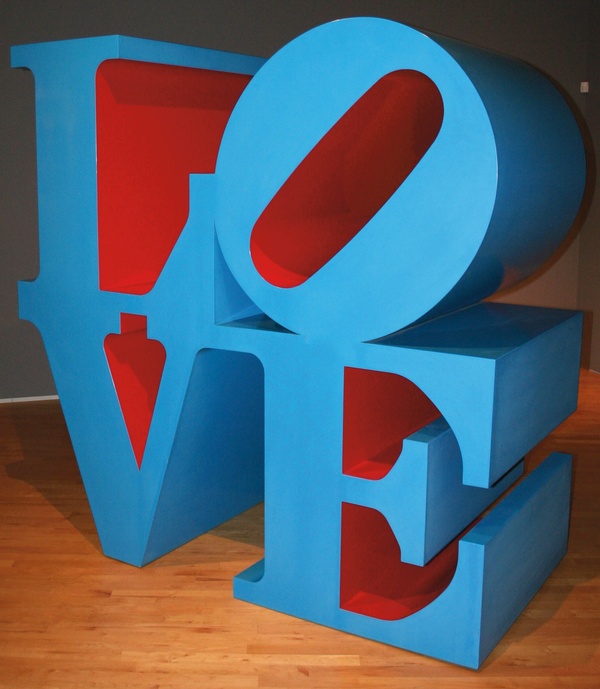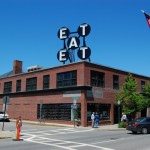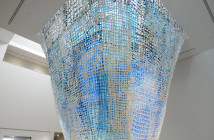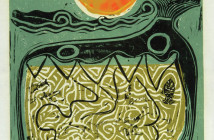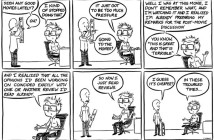ROBERT INDIANA @ THE FARNSWORTH
Walking through the five galleries bursting with Robert Indiana’s signature colorful work, stunningly displayed against muted gray walls, was like visiting the artist’s home, since most of the exhibition pieces were transplanted from the Star of Hope, Robert Indiana’s home and studio on the island of Vinalhaven, fifteen miles off of Rockland, Maine, home to the Farnsworth Art Musuem. Indiana, although still strongly associated with New York City’s thriving 1960s American Pop Art scene, has actually been a year-round islander since 1978.
Although the focus of the exhibition is ostensibly Indiana's work since his move to Vinalhaven permanently in 1978, it is somewhat hard to discern, as at least two of the five galleries of his work, not including the hallways, which include artwork, photographs of the Star of Hope, text, and in one darkened hallway the documentary by filmmaker Dale Schierholt entitled A Visit to the Star of Hope: Conversations with Robert Indiana, include some of his earliest works. Even the exhibition's beautiful, hardbound catalogue, which includes an essay on the artist by scholar John Wilmerding that delves into Indiana's personal and professional history, does not even get to Indiana's Star of Hope produced work until page twenty-five, of the thirty page essay. And it does not even touch upon his most recent work, the infamous, large, glistening, stainless steel, HOPE, synonomous with the Barack Obama campaign, and commissioned for the 2008 Democratic National Convention, until the last three paragraphs.
As an artist Indiana walks a fine line between the past and the present, repeatedly returning to certain themes, words, and numbers, each time infusing the work with a modern topical twist, or a new insight, discovery, or interpretation of his personal history, which can make it hard to distinguish between old and new work. For the most part the exhibit is arranged chronologically, besides a few exceptions, one of them being one of the first Indiana pieces you see upon entering the museum, The Eighth American Dream (2000), the largest of an ongoing series started in 1961, a date which roughly marks the transition of his work into Pop Art.
The exhibit is unavoidably text-heavy in order to sufficiently explain the significance of what may at first glance seem like simple, geometric, graphic pieces. But, the exhibit, reflective of Indiana’s personality, is multi-layered and complex. One could breeze through the exhibit and enjoy the work purely for its visual qualities, but to read every label might take one hours. The wall text reveal the stories behind the work and delve into the compelling life of an artist most known for his iconic LOVE, with the tilted letter “O,” first crafted for the MOMA as a design for a Christmas card, but came to symbolize the peace movement of the Vietnam War era. A whole room is devoted to his LOVE series, in all its forms ---- from silkscreens, to paintings, to sculptures of various mediums and sizes. The sculptural LOVE pieces are done in mediums ranging from Carrara marble to aluminum, the hardness of the material perhaps indicating the enduring quality of love, or maybe the hurt and pain one can acquire from opening oneself up to it. It is a word to which the artist has repeatedly returned, most recently in foreign languages, such as the striking yellow and red Chinese Love (2002). But, what we don't know is --- has the artist found love in his life?
Besides the recurring theme of LOVE, there is the inveterate motif EAT --- displayed prominently atop the Farnsworth in the form of a giant sign, specially reinforced to withstand the strong ocean breezes for the duration of the exhibition. The infamous lit EAT sign, is making its first appearance since its debut during the 1964 New York’s World Fair where its lights were turned off prematurely in fear that hungry fairgoers would mistake the art center for a restaurant. For this reincarnation the sign is lit by eco conscious LED bulbs. The word “EAT” is significant in that it was one of the last words that Indiana’s mother said to him on her deathbed. Awakening to his presence at her bedside, she asked her son if he’d had anything to eat before she passed away. A few more EAT pieces appear in the exhibition, including another lit piece, Electric Eat (1964) this one with EAT installed horizontally within a circle. An electrical switch is installed near the piece for viewers to switch on the blinking sign, ironically imersing the room in the type of disco-like lighting synonomous with Pop Art contemporaries of Indiana's like Andy Warhol, an atmosphere that in part compelled Indiana to flee New York for the quiet retreat of Vinalhaven.
Despite the exhibitions focus on the artist's work since moving full-time into the Star of Hope, the most powerful pieces in the exhibition are the portraits of Indiana’s adoptive parents, the Clarks, who divorced when Indiana was only ten. “Mother and Father,” a pair of tondo paintings, depict his parents in the year before his birth. Indiana worked on the paintings between 1963 and 1967. They are stunning in form, size, and color. Each parent is painted on the opposite side of a 1920s Ford, each with one hand grasping a door handle.
The portrait of his father is done in multiple tones of gray, a fedora adorning his head, a shirt and tie peeking out above the neckline of his trench coat, but bare legs sticking out below the coat, one foot on the vehicle’s running board --- as if his father is about to hop in and drive away --- possibly signifying the abandonment Indiana felt after his parents divorce and his father’s subsequent remarriages.
In contrast, his mother Carmen’s portrait is alive with color, her naked body draped in a vibrant cloak, the color of her namesake, her round breasts exposed, her hair arranged in the Flapper style of Zelda Fitzgerald. The spokes of the one visible truck wheel are bright yellow, the license plate red, and a patch of the bright blue Indiana sky shows through the truck’s back window --- the primary colors for which the artist is most identified; the red and green which are reminiscent of the colors of the Indiana gas stations of his childhood.
The other essay in the exhibition catalogue, written by interim director and chief curator of the Farnsworth, Michael K. Komanecky, explores the history of Indiana's studio and home --- the Star of Hope, to which he cites the artist was first attracted because of its name and Victorian architecture. Although besides one hallway in the museum, which includes text and images of the artist's home and studio one has to read the catalogue in order to fully understand the significance of this unique home/studio. The catalogue includes beautiful photographs of the building's exterior and interior. Both Wilmerding and Komanecky reference in their essays the fact that Indiana has said that he thinks he moved nearly 21 times during his childhood, which might have feuled the artist's desire to create a permanent home, one filled to the brim with evidence of his life and experiences.
Through Komanecky's essay we learn that Indiana has over time lovingly restored and even had the building added to the National Register of Historic Places. One of the central hallways, of the relatively open concept museum, which can be seen from the first two galleries featuring some of Indiana's earliest work, also connects the gallery with all of the Love pieces, as well as serves as the access point to the two final galleries where Indiana's most recent work is installed, including the series Hartley Elegies, HOPE, and some Maine-inspired pieces – all work that Indiana has completed since moving full-time to the Star of Hope.
One entire gallery is devoted to the Hartley Elegies, which are a series of silkscreens done in honor of Marsden Hartley, whom incidentially spent the summer of 1938 living in a building across the street from Indiana's the Star of Hope, and to whom Indiana has developed a compelling attachment and felt an almost instrinsic kinship, an attachment that has anchored Indiana to Maine. The series was originally inspired by Hartley's 1914 painting Portrait of a German Officer, that paid tribute to a close friend of his, Karl von Freyburg, who had been killed in battle. Indiana worked on this series from 1989-1994, devoting five years of his life to this incredible tribute, but at the same time personalizing it by doing the series in his own preferred medium of silkscreen, changing the color palette, and inserting stars and stripes to Americanize different pieces in the series. Wilmerding summarizes the importance of the Hartley Elegies in his essay writing that ˝For Indiana they were in part about his own similar losses and recent separation from friends in New York, and about isolation on the Maine coast. Historians have further pointed out that both men were on the move in childhood, modified their names as artists, wrote poetry, shared the conflicts of sexuality, and produced original autobiographical expressions.˝ Komanecky expands upon the shared experiences between the two artists in his essay and points out that despite having been a year-round resident of Vinalhaven since 1978, Indiana has, like Maine-native Hartley, experienced some prejudice due to his sexual orientation, and despite his celebrity in the world at large, has at times been made to feel unwelcome on Vinalhaven. After all, Indiana is, as Mainers would say ˝from away,˝ a fact which Indiana himself would not dispute and even changed his surname from Clark to Indiana when he first started working as an artist in New York in the 1950s, in order to literally attach himself to his birth state, as well as start fresh with a name he felt wasn't so common, one worthy of a rising star in the art world.
For an artist that has often been considered a hermit since his retreat to Vinalhaven, this comprehensive exhibition is highly personal, an invitation inside the home of the artist, a home the artist has single-handedly made into a ready-made museum, carefully having documented his life, obsessively gathering newspaper clippings, preserving photographs and letters, and even seeking out some of his first work from childhood teachers. The artist has been in talks with the Farnsworth about transferring the Star of Hope to their posession upon his death, so that his legacy may live on under their care. The title of the exhibition might suggest more of a focus on work created since moving into the Star of Hope, but the exhibit is a comprehensive one, and allows visitors to see the full spectrum of Indiana’s career --- successfully crafting a fascinating, visual biography.
- Robert Indiana, Love, 1996, Polychrome aluminum, 72 x 72 x 36 inches, Museum Purchase, 1999
- Robert Indiana’s EAT sculpture on the roof of the Farnsworth Art Museum, Rockland, ME
- Robert Indiana, HOPE, 2008, stainless steel, 72x72x36, collection of Michael McKenzie
"Robert Indiana and the Star of Hope" is on view June 20, 2009 – October 25, 2009 at The Farnsworth Art Museum.
All images are courtesy of The Farnsworth.

